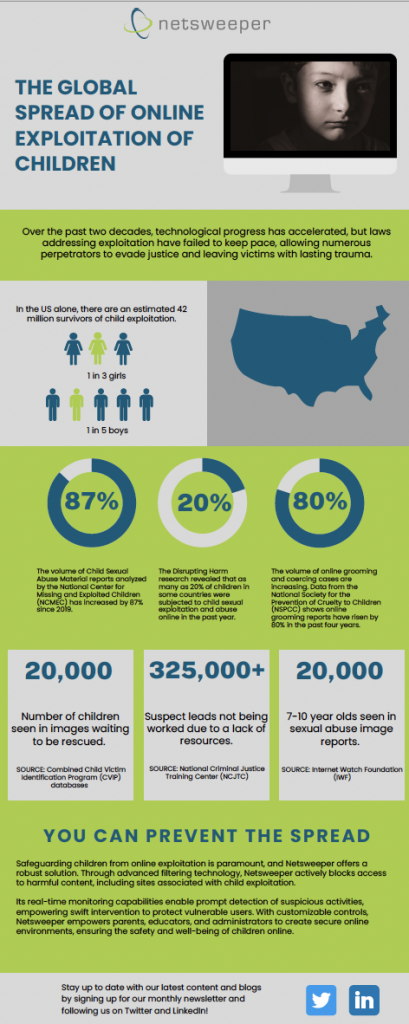The rapid evolution of digital technology has brought about unprecedented opportunities for connectivity and information access, but alongside these advancements lurks a dark and troubling reality: the proliferation of Child Sexual Abuse Material (CSAM) online. As we delve into the latest findings from 2023, it becomes increasingly evident that the digital landscape has become a breeding ground for exploitation, posing grave risks to the safety and well-being of our youth.
As we look back on 2023, it is crucial not only to understand current trends but also to keep up with past patterns, stay ahead of emerging threats, and explore potential avenues for intervention and prevention.
1. Heightened Risk of Online Sexual Harm Among Children in Economically Underprivileged Communities
The advent of increased internet accessibility among minors has brought about a broader spectrum of risks, particularly regarding sexual exploitation and abuse. Recent findings reveal a distressing reality: globally, 54% of respondents aged 18 to 20 have encountered some form of online sexual harm. Moreover, individuals identifying as members of minority groups, such as LGBTQ+ individuals, are disproportionately affected, with 65% reporting experiences of online sexual abuse. This underscores the urgent need for targeted interventions to protect vulnerable populations from exploitation online.
2. Surge in ‘Self-Generated’ CSAM Content
The proliferation of ‘self-generated’ CSAM content represents a troubling trend in recent years. Data from the Internet Watch Foundation (IWF) paints a stark picture: between 2018 and 2022, the proportion of webpages flagged by the IWF featuring ‘self-generated’ sexual imagery skyrocketed from 27% to 78%. Alarmingly, children aged 11 to 13 are prominently featured in reports of such imagery, with girls in this age group comprising 50% of all reports actioned by the IWF in 2022. This underscores the need for comprehensive strategies to address the root causes driving the creation and dissemination of such harmful content.
3. Heightened Risk of Grooming and Financial Sexual Extortion on Social Media and Gaming Platforms
Minors are increasingly vulnerable to grooming and financial sexual extortion on popular social media and gaming platforms. The National Center for Missing and Exploited Children (NCMEC) reported a staggering increase in such crimes, with over 10,000 cases reported in 2022 compared to just 139 the previous year—an alarming 7200% surge. This concerning trend has prompted the US FBI to issue a public safety alert, highlighting the involvement of offshore criminal syndicates in orchestrating these schemes. Online multiplayer games, in particular, have emerged as hotspots for predatory behavior, with perpetrators initiating high-risk grooming conversations within seconds of initial contact and engaging in prolonged grooming over an average period of 45 minutes.
4. Emergence of AI-Generated CSAM as a Growing Threat
A particularly concerning development in the realm of online exploitation is the emergence of AI-generated CSAM. In the past year, there has been a notable increase in cases where online predators exploit generative AI services to create and distribute illicit content. A recent investigation by the IWF uncovered 29 reports of URLs containing suspected AI-generated CSAM, with 7 confirmed cases of synthetic media. These offenders often disseminate such content on image-sharing platforms while promoting links to additional illicit material hosted on other platforms, some of which is accessible behind paywalls. This insidious trend highlights the need for proactive measures to detect and combat AI-generated CSAM effectively.

Creating a Safe Space Online
As children increasingly rely on the internet for various aspects of their education and daily lives, ensuring their safety and security online becomes paramount. Implementing appropriate safeguarding measures is crucial to enable young people to benefit from the internet’s positive aspects while minimizing risks. This approach helps foster a safer online environment, allowing children to explore the digital world with confidence and enjoy its benefits without compromising their well-being.
Netsweeper plays a pivotal role in creating a secure online environment for children through its advanced filtering and monitoring capabilities. By leveraging sophisticated filtering algorithms, Netsweeper effectively detects and blocks access to harmful content, including sites associated with online sexual exploitation and abuse. Real-time monitoring enables swift identification of suspicious activities, allowing for timely intervention to protect vulnerable users. Furthermore, Netsweeper offers customizable controls that empower parents, educators, and administrators to tailor online experiences, ensuring age-appropriate and safe browsing for children.
The rise of CSAM underscores the urgent need for concerted action to protect children from online exploitation. By leveraging innovative solutions like Netsweeper and implementing comprehensive education and support initiatives, we can work together to create a safer digital landscape for all.
